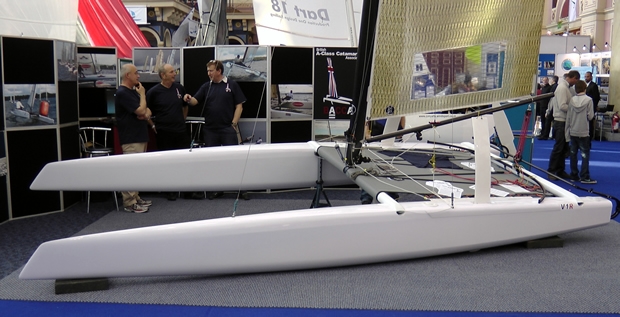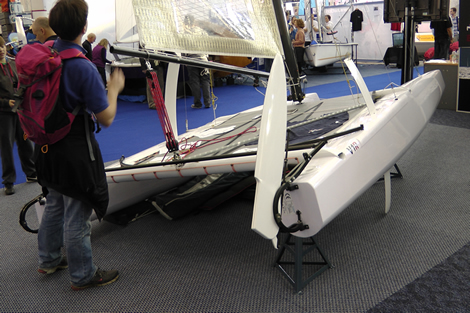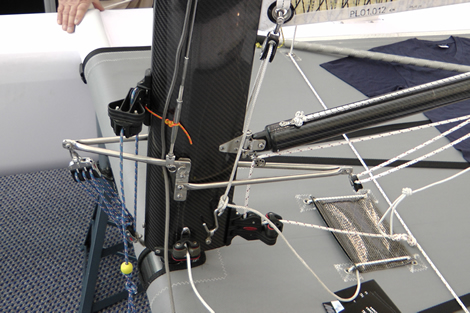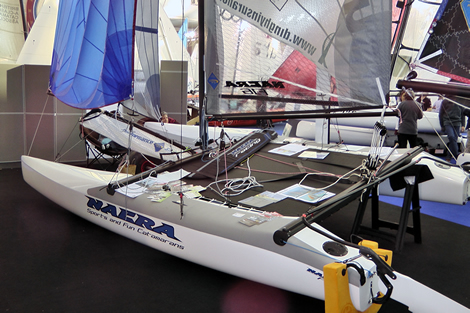
Catamarans at the RYA Dinghy Show
Still hidden away in a far corner, the square footage of stand space at the RYA Dinghy Show nonetheless continues to grow for catamaran exhibitors.
We were particularly pleased to see the British A-Class Catamaran Association taking a stand for the first time in living memory. On display was a brand new Italian-built Bimare V1R – which very much looks the part with its long wave piercing bows, its main cross beam some way aft of the centrepoint fore and aft and of course the ORMA 60-style curved daggerboards, fitted around a quarter of the way forward from the transom.
The Association’s Struan Wallace (owner of the fine vessel) and Chairman Colin Bannister told us that at present the class is growing almost from scratch in the UK. Even they are both relatively new to the class coming from the Hurricane and F18 classes. “I came back to the A-Cat because they are singlehanded,” Bannister told us. “I didn’t want to be messing around with a kite and they are light. You don’t have to think about a crew. It takes about 15 minutes to rig.”
They are now up to 15-16 members with the largest gathering of boats being the seven at Rutland. “We are doing a lot that we can to build the fleet in the UK. There is a lot of interest from prospective America’s Cup sailors who are moving to A-Cats,” Bannister continues.
We heard elsewhere that a few Skandia Team GBR Olympic sailors have been planning to all get A-Cats and had a pact limiting how much money they were going to spend...until Finn ace Giles Scott recently blew this out of the water when he purchased a Bimare.
New A-Cats are not cheap. The new Bimare model displayed at the RYA Dinghy Show costs around 16,000 Euros, while the Dutch-built DNA, which at present is picking up the most metalware at championships, is about 21,000 Euros and the Marstrom M5 is around 30,000. However the good news is that there is a strong market on the continent for secondhand gear, with competitive boats changing hands for 6,000-10,000 Euros.
The boats are certainly in the top five of coolest dinghies to own – as an indicator many America’s Cup designers sail them in their spare time and of course many Cup sailors have taken to them in the last couple of years to get up to speed on two hulls.
The A-Cat is a development class, the smallest of the four IYRU catamaran class rules written back in 1963 but in addition to its original limits - 18ft (5.49m) long with 7ft 6in (2.3m) beam and a maximum sail area (including mast) of 150sqft (13.94sqm) - to prevent escalating costs there is also a minimum weight limit of 75kg. Boats are fully carbon and typically A-Class cats haven’t gone down the solid wingsail route of the bigger C-Class cats, although the exception was the boat Ben Hall put together for the 2007 World Championship in Florida.
“The curved boards are the main thing at the moment,” Bannister says. “The DNA – they have made their boards thinner and longer – they are doing what the F18s have done. Whether it works or not...we don’t know yet.”
The 2012 generation Bimares have boards with a little more cord as last year they were causing the boats to create too much leeway at low speeds, most apparent on the start line. They have also made the hulls narrower. “Because it is a development class they can do whatever they want to optimise it,” points out Bannister.
However sail controls are also developing and the Bimare on display for example had two sets of shrouds and a grunty purchase system inside the mast for adjusting the spreaders. “You have your downhaul, but the main thing you’ll set up your diamonds to one pre-tension that is suitable for your weight and then when it starts picking up a bit more you have this mast control for powering up the diamonds even more. We can take it from 27° to 32-34 and that has the effect of pushing the mast even more forward, so it will flatten the middle of the sail even more, so it gives us more of a windsurfer effect.”
In fact Banister advises that when buying a secondhand boat the mast and sail is almost more important than the platform. “The platforms are all getting very similar but it is no good having a really good platform if you have got a bad mast and sails.”
As ever with tweaky high performance boats like this, Banister says that getting up to 80% of the boat's performance is easy. It is eeking out the last 20% that separates the good A-Cat sailors from the less adept.
UK built A-Class imminent
When one thinks of the UK A-Class cats, the Unicorn usually springs to mind, even though it is now getting on for 50 years old...However a few doors down the road from the Reg White empire in Brightlingsea, Graham Eeles has a new boat on the cards.
Eeles has been working with US-based A-Cat designer Peter Coogan, who was involved in the development of Ben Hall’s boat mentioned earlier. According to Eeles this project has been in gestation for a couple of years, but recently they have gone back to the drawing board to come up with a new design, particularly spending more time looking at how the curved daggerboards work.
The button is expected to be pressed on building the new design imminently with a launch date of the late spring this year. Eeles is also currently building a carbon fibre Farrier 32 trimaran.
F18 European championship
As reported recently the F18 class has come up with a new European Championship for this year where, from a long list of regattas across Europe, sailors can pick their best three results. This initiative came out of a meeting at the Europeans in Gran Canaria last autumn when it was decided that while the F18 remains the most popular of the dinghy cat classes, there is some new competition knocking on their door – the most obvious being the F16, such the new Nacra 16 (which was also on display at the show) which is one of the candidates up for selection to be the new mixed multihull for the Rio 2016 Olympic Games.
“It is just to encourage F18 sailing and make the class work as a unit,” F18 sailor Oli Egan told us. “In England we have a problem with getting the Dutch to travel over to us, so we have picked Minnis Bay which is close to Dover to hold our Nationals. Plus Minnis can hold 60-90 boats if we have to.”
Considering that F18 World Championships when they are held in Europe typically have more than 100 boats entered, it possible that over the course of the new European Championship 250-300 F18s might take part – it is hard to think of how many other classes could achieve such numbers.












Latest Comments
Add a comment - Members log in